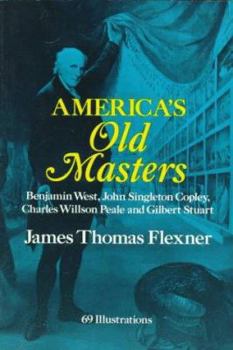America's Old Masters: Benjamin West, John Singleton Copley, Charles Willson Peale and Gilbert Stuart
Select Format
Select Condition 
Book Overview
Profiles the four eighteenth-century painters who earned the earliest international acclaim for American art. This description may be from another edition of this product.
Format:Paperback
Language:English
ISBN:048627957X
ISBN13:9780486279572
Release Date:February 1994
Publisher:Dover Publications
Length:448 Pages
Weight:1.40 lbs.
Dimensions:1.1" x 5.6" x 8.2"
Customer Reviews
2 ratings
An enjoyable introduction to America's earliest great artists
Published by Thriftbooks.com User , 16 years ago
James Flexner first wrote this book (since revised) in 1939, when he says that it was agreed that the United States had produced no worthy art, certainly not back in the late 18th and early 19th century when the four artists discussed here were painting, i.e., Benjamin West, John Singleton Copley, Charles Willson Peale and Gilbert Stuart. All of the artists were initially self-taught, or trained by artists inferior to themselves, but did later get European training. Nonetheless, Flexner maintains that at their best, they retained uniquely American characteristics, in particular an sense of realism in an era when idealization was much praised. They spent most of their time doing portraits, although some of them hated it, because Americans had no interest in landscapes, or the history paintings that were then consider particularly high-brow art. The book has been revised before this edition was published, and some color plates were added to the original 69 half-tones. The plates are often rather muddy (perhaps this is because I have the book club edition.) This was later reissued in the 1990s, so maybe the illustrations have been upgraded. Flexner is an agreeably genial guide. Perhaps because he was initially defending works that were considered worthless when he began to write, although they were often highly regarded in their own time, he warns the reader against assuming that current taste in art is "correct." He points out the historical changes in taste, and sometimes admits to finding some works not to his own taste, but he isn't oppressively didactic. In recounting the lives of the painters, he sometimes points out obvious errors, but instead of using them to accuse the autobiographer/biographer of being a pathological liar, as many biographers do, he is willing to attribute them to honest lapses of memory if possible. I thoroughly enjoyed the book.
An enjoyable introduction to America's earliest great artists
Published by Thriftbooks.com User , 16 years ago
James Flexner first wrote this book (since revised) in 1939, when he says that it was agreed that the United States had produced no worthy art, certainly not back in the late 18th and early 19th century when the four artists discussed here were painting, i.e., Benjamin West, John Singleton Copley, Charles Willson Peale and Gilbert Stuart. All of the artists were initially self-taught, or trained by artists inferior to themselves, but did later get European training. Nonetheless, Flexner maintains that at their best, they retained uniquely American characteristics, in particular an sense of realism in an era when idealization was much praised. They spent most of their time doing portraits, although some of them hated it, because Americans had no interest in landscapes, or the history paintings that were then consider particularly high-brow art. The book has been revised before this edition was published, and some color plates were added. The plates are often rather muddy. This was later reissued in the 1990s, so perhaps the illustrations have been upgraded. Flexner is an agreeably genial guide. Perhaps because he was initially defending works that were considered worthless when he began to write, although they were often highly regarded in their own time, he warns the reader against assuming that current taste in art is "correct." He points out the historical changes in taste, and sometimes admits to finding some works not to his own taste, but he isn't oppressively didactic. In recounting the lives of the painters, he sometimes points out obvious errors, but instead of using them to accuse the autobiographer/biographer of being a pathological liar, as many biographers do, he is willing to attribute them to honest lapses of memory if possible. I thoroughly enjoyed the book.






